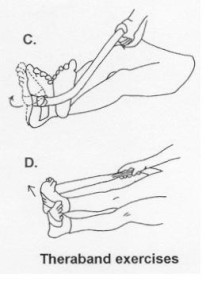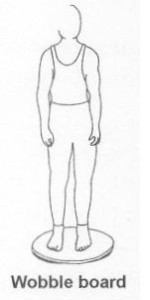As soon as you can tolerate pressure on the ball of your foot, begin stretching your ankle using the towel stretch. When this stretch is too easy, try the standing calf stretch and soleus stretch. You can do exercises 4 and 5 when your ankle swelling has stopped increasing. You may do exercises 6 through 10 when you can stand on your injured ankle without pain.
1. Towel stretch:
Sit on a hard surface with your injured leg stretched out in front of you. Loop a towel around the ball of your foot and pull the towel toward your body, keeping your knee straight. Hold this position for 30 seconds. Repeat 3 times.
2. Standing calf stretch:
Facing a wall, put your hands against the wall at about eye level. Keep the injured leg back, the uninjured leg forward, and the heel of your injured leg on the floor. Turn your injured foot slightly inward (as if you were pigeon-toed). Slowly lean into the wall until you feel a stretch in the back of your calf. Hold for 30 seconds. Do this several times a day.
3. Standing soleus stretch:
Stand facing a wall with your hands at about chest level. With both knees slightly bent and the injured foot back, gently lean into the wall until you feel a stretch in your lower calf. Once again, angle the toes of your injured foot slightly inward and keep your heel down on the floor. Hold this for 30 seconds. Return to the starting position. Repeat 3 times.
4. Ankle range of motion:
You can do this exercise sitting or lying down. Pretend you are writing each of the letters of the alphabet with your foot. This will move your ankle in all directions. Do this twice.
5. Thera-Band exercises
 A. Resisted dorsiflexion:
A. Resisted dorsiflexion:
Sitting with your leg out straight and your foot near a door, wrap the tubing around the ball of your foot. Anchor the other end of the tubing to the door by tying a knot in the tubing, slip- ping it between the door and the frame, and closing the door. Pull your toes toward your face. Return slowly to the starting position. Repeat 10 times. Do 3 sets of 10.
B. Resisted plantar flexion:
Sitting with your leg outstretched, loop the middle section of the tubing around the ball of your foot. Hold the ends of the tubing in both hands. Gently press the ball of your foot down and point your toes, stretching the Thera-Band. Return to the starting position. Repeat 10 times. Do 3 sets of 10.
 C. Resisted inversion:
C. Resisted inversion:
Sit with your legs out straight and cross your un- injured leg over your injured ankle. Wrap the tubing around the ball of your injured foot and then loop it around your uninjured foot so that the Thera-Band is anchored at one end. Hold the other end of the Thera-Band in your hand. Turn your injured foot inward and up- ward. This will stretch the tubing. Return to the starting position. Repeat 10 times. Do 3 sets of 10.
D. Resisted eversion:
Sitting with both legs out stretched and the tubing looped around both feet, slowly turn your figured foot upward and outward. Hold this position for 5 seconds. Repeat 10 times. Do 3 sets of 10.
6. Heel raises:
Standing, balance yourself on both feet behind a chair. Rise up on your toes, hold for 5 seconds and then lower yourself down. Repeat 10 times. Do 3 sets of 10.
7. Toe raises:
Stand in a normal weight-bearing position. Rock back on your heels so that your toes come off the ground. Hold this position for 5 seconds. Repeat 10 times. Do 3 sets of 10.
8. Single leg balance:
Stand without any support and attempt to balance on your injured leg. Begin with your eyes open and then try to perform the exercise with your eyes closed. Hold the single-leg position for 30 seconds. Repeat 3 times.
9. Skipping rope:
Jump rope landing on both legs for 5 minutes, then on only the injured leg for 5 minutes.
10. Wobble board:
 This exercise is important to restore balance and coordination to your ankle. Your physiotherapist can instruct you on their use and will use them in your rehabilitation. Make a wobble board by cutting a circle of plywood two feet across. Place it on top of a 5 or 10 pound weigh, from a barbell set. Stand on the wobble board. Balance first on both legs, then on the injured leg. Do this for 2 to 5 minutes 3 times a day. You may need to hold onto a chair or table for balance.
This exercise is important to restore balance and coordination to your ankle. Your physiotherapist can instruct you on their use and will use them in your rehabilitation. Make a wobble board by cutting a circle of plywood two feet across. Place it on top of a 5 or 10 pound weigh, from a barbell set. Stand on the wobble board. Balance first on both legs, then on the injured leg. Do this for 2 to 5 minutes 3 times a day. You may need to hold onto a chair or table for balance.